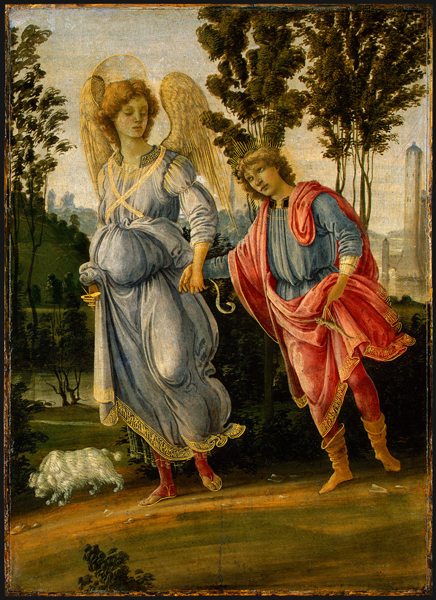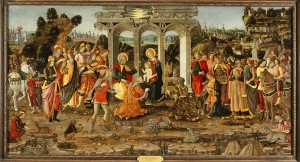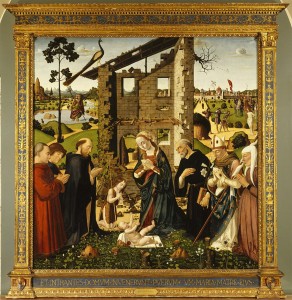
Filippino Lippi
Tobias and the Angel, c. 1475/80
Oil and tempera (?) on panel, 32.7 x 23.5 cm (12 7/8 x 9 1/4 in.)
National Gallery of Art, Washington, DC, Samuel H. Kress Collection
Image courtesy of the Board of Trustees, National Gallery of Art
Kicking and squirming, the lively Jesus in Botticelli’s Adoration of the Child is a far cry from the immobile, tightly swaddled infants found in medieval painting. Working in a static medium that tends to arrest motion and freeze time, fifteenth-century painters applied themselves to the challenge of conveying a convincing impression of lifelike movement as a means of bringing to life the long-ago stories of scripture. In Tobias and the Angel, a work by Botticelli’s assistant, Filippino Lippi, the figures appear to totter midstride as they descend a gentle slope. Shifting weight onto the downhill leg while lifting the trailing leg off the ground, the figures adopt unstable poses which, together with the pull of gravity, suggest lateral momentum—as if the pair could walk right out of the picture. The resulting impression of imminent movement mitigates somewhat the fixed nature of the medium of painting. That Lippi represented Tobias and his angelic companion Raphael with their heads partly inclined toward each other adds to our expectation of movement, as if their swiveling motion will continue and their eyes will meet.
Tobias and the Angel
Tobias was sent by his father, Tobit, on an arduous journey to collect a longstanding debt. Unbeknownst to Tobias, his traveling companion was the angel Raphael, sent by God after Tobit was stricken with blindness. On the journey, Raphael aided Tobias in various ways: directing him to the best route, protecting him from dangers, and helping him catch a monstrous fish that tried to eat him. After collecting the debt, Raphael returned with Tobias (now married) to Tobit’s house, where he explained how to use the fish to treat Tobit’s blindness.
The convincing suggestion of potential or actual movement was fundamental to the lifelike quality Renaissance artists pursued in representing the human figure. It was not enough merely to replicate the physical disposition of the limbs; painters also endeavored to convey the emotion and spirit that animated the body. In his discussion of a category of narrative subjects known as istoria, the artistic polymath Leon Battista Alberti asserted:
Movements of the soul are made known by movements of the body. Care and thought weigh so heavily that a sad person stands with his forces and feelings as if dulled, holding himself feebly and tired on his pallid and poorly sustained members. . . . In gay and happy men the movements are free and with certain pleasing inflections. . . .Thus all the movements of the body should be closely observed by the painter. These he may well learn from nature, even though it is difficult to imitate the many movements of the soul.4
![Leonardo da Vinci<br /><i>Sheet of Studies</i> [recto], probably 1470/1481<br />Pen and brown ink over black chalk on laid paper, 16.4 x 13.9 cm (6 7/16 x 5 1/2 in.)<br />National Gallery of Art, Washington, DC, The Armand Hammer Collection<br />Image courtesy of the Board of Trustees, National Gallery of Art](http://italianrenaissanceresources.com/wp-content/uploads/2013/02/RP_208-253x300.jpg)
Leonardo da Vinci
Sheet of Studies [recto], probably 1470/1481
Pen and brown ink over black chalk on laid paper, 16.4 x 13.9 cm (6 7/16 x 5 1/2 in.)
National Gallery of Art, Washington, DC, The Armand Hammer Collection
Image courtesy of the Board of Trustees, National Gallery of Art
You must go about, and constantly, as you go, observe, and consider the circumstances and behaviour of men in talking, quarrelling, or laughing or fighting together: the action of the men themselves and the actions of the bystanders, who separate them or who look on. And take a note of them with slight strokes thus, in a little book which you should always carry with you. . . . Keep these [sketches] as your guides and masters.5

Jacopo del Sellaio
The Adoration of the Magi, c. 1480–90
Tempera on wood panel, 89.2 x 170.8 cm (35 1/8 x 67 1/4 in.)
Memphis Brooks Museum of Art, Gift of the Samuel H. Kress Collection
- A youth throws up his hands in astonishment.
- A few men reach out toward the holy family while eagerly stepping closer.
- Others turn around to see how their neighbors are reacting.
- A seated monkey holds out a cup, while a dog lover teaches his canine companion to shake.
Caught in mid-gesture or midstep, the figures create an impression of quivering motion that enlivens the central scene.
Some viewers might have found it unseemly to crowd the Adoration of the Magi with so many distracting details. Religious strictures discouraged frivolous or indecorous elements in representations of sacred subjects. In his Summa Theologica of 1450, Antonio Pierozzi (1389–1459), Archbishop of Florence, observed:
To paint curiosities into the stories of saints and in churches, things that do not serve to arouse devotion but laughter and vain thoughts—monkeys and dogs chasing hares and so on, or gratuitously elaborate costumes—this I think unnecessary and vain.6
Many painters nonetheless delighted in representing such vivacious details. Striking a balance between permanence and transience, they often relegated lively anecdotal elements to peripheral areas so they would not impinge on the timeless dignity of the holy event in the central foreground.
Serenity prevails, for example, in the sacred foreground scene of The Adoration of the Child with Saints and Donors, c. 1476, by Biagio d’Antonio. (see interactive) In the background, however, human life goes on:

Biagio d’Antonio
The Adoration of the Child with Saints and Donors, 1476
Oil on linden wood panel, 185.4 x 181 cm (73 x 71 1/4 in.)
Philbrook Musem of Art, Tulsa, Gift of the Samuel H. Kress Foundation
- At right, three archers carry out, respectively, the consecutive actions of taking aim, drawing back the arrow, and recharging the bow.
- Behind them, four horsemen look on; one bears a fluttering Roman banner while another shields his eyes from the sun.
- Farther back, a deer lowers its head to graze while two others flee from a path where men and women stroll.
- Above, a flock of birds flies in formation, fading into the depths of the sky.
- Puffs and streaks of clouds float into the picture plane and then disappear from view behind the ruined wall.
Contrasting the hustle and bustle of everyday life with the unearthly calm of the mystical event in the central foreground, Biagio underscored the distinctiveness of the sacred realm as eternal, otherworldly, and timeless (see Discussion Questions).